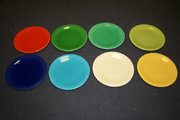Fiestaware
|
|
Fiestaware is the name of a line of dinnerware first made by the Homer Laughlin company in 1936.
Fiestaware gained popularity during the Great Depression for its bright colors, durable construction, and stylized art deco design. Its higher price made it a status symbol of the 1940s middle-class household. Today, old Fiestaware trades briskly on auction websites as at other antique/vintage product sales venues.
Some pieces of old, red-colored Fiestaware are now famous for having a large amount of uranium in their glaze to produce their bright orange-red color. After the negative effects of radioactivity were realized, red Fiestaware plates were deemed potentially harmful. However, it was a shortage of uranium for WWII that caused the orange-red line to be discontinued in 1944, not a radioactivity scare.
Old red Fiestaware plates are much more radioactive (but not necessarily harmful) than other radioactive housewares, such as uranium glass. Such plates are now prized items to radioactivity collectors.
The orange-red uranium-glazed line of Fiestaware was reintroduced in the 1960s, with depleted uranium as its base, which was touted as a harmless form of the element.
The Fiestaware line was discontinued in 1973.
Fiestaware was reintroduced in 1986 for its 50th anniversary, and is still sold today by the Homer Laughlin China Company.
External links
- Homer Laughlin China Company (http://www.hlchina.com/), makers of Fiestaware
- Fiestaware at the Smithsonian (http://www.smithsonianlegacies.si.edu/objectdescription.cfm?ID=223)
- Dangerous Laboratories: Radioactive Glass (http://www.dangerouslaboratories.org/rglass.html) includes red Fiestaware
- Theodore Gray's Periodic Table: Uranium (http://www.theodoregray.com/PeriodicTable/Elements/092/) collection includes two pieces of red Fiestaware

